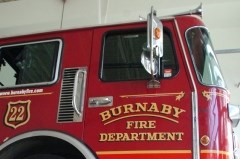While public health officials continue to grapple with an epidemic of illicit drug overdoses around the province, in large part related to fentanyl, Burnaby’s fire department is taking a wait-and-see approach to carrying the life-saving treatment naloxone.
Deputy fire chief Dave Samson said the fire department is not currently administering naloxone, but the possibility of doing so in the future is being discussed at the management level and at the city’s public safety committee.
Meanwhile, all ambulance crews and 46 fire departments around the province are now carrying naloxone, including the Vancouver and Surrey fire departments.
Samson explained the department is gathering data on the issue, noting in July a separate code for overdoses was created to better track the data before making a decision.
“It’s certainly a concern to us for the public,” Samson told the NOW. “We’re concerned for our own members, it’s something we’re looking at, there’s just no firm decision on it yet, (we’re) just gathering data.”
Last week, the province’s chief coroner provided an update on the number of overdoses in B.C., which showed the total deaths from illicit drug use at 488, an increase of 61.6 per cent from the same time period in 2015.
The latest numbers also show that fentanyl remains a major contributor to the high number of deaths. According to the BC Coroners Service, between Jan. 1 and July 31, there were a total of 264 deaths in which fentanyl was detected, which is about 60 per cent of all illicit drug deaths.
The only sliver of good news was that the number of overdose deaths in August was smaller than for the same month in 2015.
In April, B.C.’s provincial health officer declared the overdose situation a public health emergency.
Closer to home, there have been 13 illicit drug overdose deaths recorded in Burnaby so far this year. It’s not clear how many of those deaths involved fentanyl.
Samson said the department is seeing a steady increase in the amount of overdose calls, noting there have been 20 overdoses since the end of July. He also noted those numbers have not been broken down to how many involve fentanyl.
The deputy chief also pointed out the overdoses are happening to people from all walks of life and ages. But the overdoses in younger people are particularly hard on firefighters.
“We don’t like to see anybody in distress, but like anybody else when it’s younger people that are unresponsive, it’s a bigger impact on everybody,” Samson said.
It remains unclear if or when the Burnaby fire department will be added to the list.
Coun. Anne Kang, who sits on the city’s public safety committee, said the committee is waiting to for more information before weighing in on the issue. However, personally, she said she’s leaning toward not supporting the fire department administering naloxone. Kang added she doesn’t want to make any changes until the studies come back.
She also wants to consult with the fire department and find out how firefighters feel about administering the drug.
“It’s an emerging issue and it’s something we’re all very concerned about,” Kang said. “Whenever it comes to medical safety, we’re hoping to make the best decision by a nice consultative report that comes out.”
B.C.’s chief coroner Lisa Lapointe said this about naloxone in a statement last week: “We know from our health and public safety partners that many deaths are being prevented through the use of naloxone. Without the work that has been done to increase the availability of this antidote to opioid overdoses, I fear we would have seen many more deaths. But no one should ever assume that the presence of naloxone at a scene will automatically mean a good outcome.



